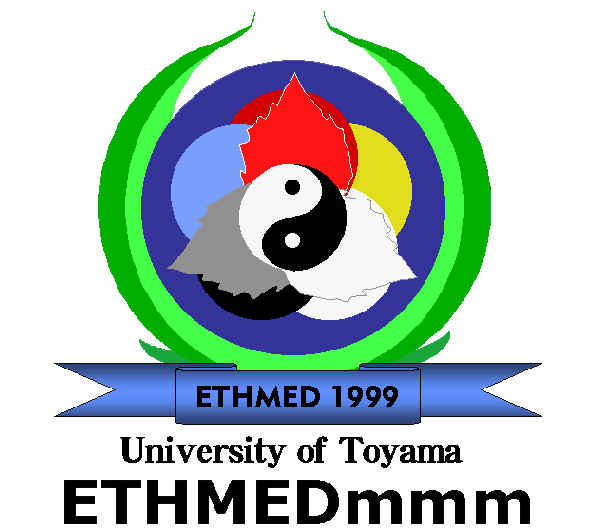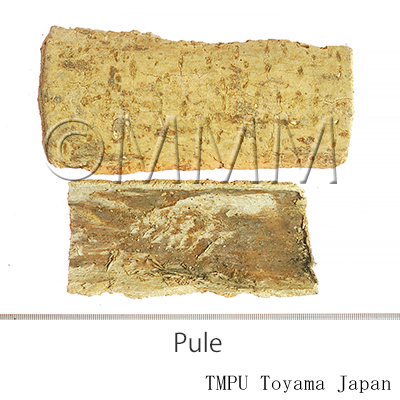Crude drug sample data base
※Click on the image to enlarge it.
The capital city, provincial capital city or the representative
location of its administrative area is indicated.
location of its administrative area is indicated.
Production area information
https://ethmed.toyama-wakan.net/img/pin_san.png
-7.7955798
110.36948959999995
Collection information
Republic of Indonesia,Special Region of Yogyakarta
https://ethmed.toyama-wakan.net/img/pin_nyu.png
Scientific information data base
| Crude drug name | Indonesian name, English name | Pule, Hard alstonia, Hard milk wood | ||||
|---|---|---|---|---|---|---|
| crude drug image |
| |||||
| Original plant name | Alstonia scholaris (L.) R. Br. | |||||
| Family name | Apocynaceae | |||||
| Used part | Bark, leaves | |||||
| Distribution area | It is the most widely distributed among Alstonia species, that grows in India, Southeast Asia, South China and Queensland. It occurs throughout Indonesia. In Java it grows in teak forests, mixed forest from lowland to 1050 m altitude [201, 220, 228]. | |||||
| Description | The bark is smooth, typically black or dark brown containing bitter, milky latex. The inner bark is bright yellow. The branches are umbrella-like and whorled. The plant is a large tree. Leaves simple, without stipules, pendulous, 5-8 and forming terminal whorls. The petiole is long, stout and channelled above with several, conspicuous close straight, parallel secondary nerves at right angle from the midrib. Blades are narrowly elliptical to obovate, apex obtuse or rounded, with 25-45 pairs of secondary veins. Inflorescence mostly formed of dense bunches of flowers. The fruit is a slender, cylindrical, pendulous and rare pairs of follicles with small seeds [228]. | |||||
| Drug effect | Bitter, cooling [231]. | |||||
| Frequency in use | Moderate | |||||
| Common uses | The wood tastes bitter and has white colour. It is soft and therefore was seldom used by people. Young wood is often used as a stopper, especially for keeping oil in bottles or other containers [201]. | |||||
| Pharmacological effect | Echitamine chloride has been examined for its anticancer effects. It affects cellular and mitochondrial respiration leading to the reduction of the cellular energy pool and thereby resulting in the loss of viability of cells [220]. Aqueous extracts of the bark significantly lower the elevation of serum transaminase and reduce the histopathological change caused by carbon tetrachloride, which is an indication of hepatoprotective property [228]. Extracts of Alstonia scholaris (L.) are included in patented cosmetic preparations because of the anti-tyrosine kinase, anti-aging and collagen-forming properties [228]. In vitro study was conducted to examine the anticancer effect of various doses of an alkaloid fraction of Alstonia scholaris in cultured human neoplastic cell lines. Results indicated that treatment with the fraction give a concentration dependent decline in the viable cells. The effect of the fraction was even better than cyclophosphamide which was used as a positive control [PMID: 16444661]. From the in vitro study on the bronchodilatory activity of the ethanolic extract of Alstonia scholaris leaves, it was known that the leaves have broncho-vasodilatory activity mediated presumably by prostaglandins, calcium antagonism and endothelium-derived relaxing factors [PMID: 1584987]. From the study to evaluate the antifertility effect of Alstonia scholaris bark extract in male rats, it was known that the extract has a significant antifertility effect with the primary site of action may be post meiotic germ cells [PMID: 12364971]. | |||||
| Medical system | Indonesian medicine (Jamu) | |||||
| Traditional usage | Bark is famously known as ''babakan pule'' in traditional medicine vendors in Java Island. Generally, the bark is used as one of the ingredients for treating skin diseases. It is used traditionally to stop diarrhoea/diarrhea, treat diabetes and haemorrhoids/hemorrhoid. An infusion of young leaves is used to treat beri-beri. The leaf tips, roasted with coconut are used to treat stomatitis [228]. The decoction of bark is used to treat malaria and diabetes. Bark together with turmeric, ginger and nutmeg are boiled to make a decoction for uterine cleansing after parturition. Crushed bark mixed with lime water is an appetite stimulant [201]. The juice obtained from a mixture of crushed bark 9 (inner part of bark) with water is used to strengthen the abdomen [201]. A mixture of crushed bark with acetic acid is used as a carminative and to treat splenomegaly [201]. A mixture of bark, leaves of Caesalpinia sappan, leaves of Blumea balsamifera is crushed and add some water, strain and could be drunk to treat fever [201]. A poultice made from the leaves is a good remedy against skin diseases [201]. | |||||
| Formulation | 1) Malaria: Two grams of bark is boiled with 110 ml of water, stand to cool and strain. Drink the decoction 100 ml once a day for 14 days [231]. 2) Diabetes: One teaspoon of powdered bark is boiled with 110 ml of water, stand to cool and strain. Drink the decoction 100ml once a day for a month [231]. | |||||
| References | Reference book Tips! | [201] K. Heyne, Tumbuhan Berguna Indonesia, Vols. 1-4, 1987. Diedarkan Oleh Koperasi Karyawan Departemen Kehutanan, Jakarta, Indonesia. Vol. 3, pp 1627-1629. [220] van Valkenburg, J.L.C.H. and Bunyapraphatsara, N. (editors). Plant Resources of South-East Asia No. 12 (2). Medicinal and posionous plants 2. Prosea Foundation, Bogor, Indonesia, 2002. pp 67-68. [222] P.T. Eisai Indonesia: Medical Herb Index in Indonesia (Second edition).1995. p 195. [228] Christophe, Wiart.: Medicinal Plants of Southeast Asia. Prentice Hall. Malaysia. 2002. p 221. [231] Soedibyo, Mooryati: Alam Sumber Kesehatan: Manfaat dan Kegunaan (Natural resources for health. Benefits and uses). Balai Pustaka. 1998. p 309. | ||||
| Research paper | 1. Jagetia GC, Baliga MS. Evaluation of anticancer activity of the alkaloid fraction of Alstonia scholaris (Sapthaparna) in vitro and in vivo. Phytother Res., 20(2):103-9 ,2006. (PMID: 16444661) 2. Gupta RS, Sharma R, Sharma A, Bhatnager AK, Dobhal MP, Joshi YC, Sharma MC. Effect of Alstonia scholaris bark extract on testicular function of Wistar rats. Asian J Androl., 4(3):175-8, 2002. (PMID: 12364971) 3. Shvalev VN, Guski H, Fernandez-Britto JE, Sosunov AA, Pavlovich ER, Anikin AYu, Zhuchkova NI, Kargina-Terentyeva RA. Neurohistochemical and electron microscopic investigations of pathological and age-related changes in the cardiovascular system. Acta Histochem Suppl., 42:345-52, 1992. (PMID: 1584987) | |||||
| Remarks | [DNA sequences]: GU974062, FJ449631, DQ660558, DQ660680, DQ660748 The bark was listed in the British Pharmacopoeia (1914 edition) as an anti-malarial drug [228]. In Java the wood was formerly used for school blackboards, hence the name ''scholaris'' [220]. The effectiveness of Alstonia in the treatment of malaria is controversial. The antiplasmodial effect of echinatine, one of the major alkaloids, is very limited. However, despite the absence of anti-malarial activity a dose-dependent improvement of the condition combined with delayed mortality was noticed amongst mice infected with Plasmodium berghei receiving a methanolic extract of A. scholaris bark [220]. | |||||
| Last renewal date | 2024/03/12 | |||||






